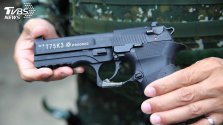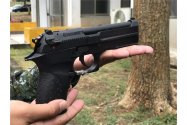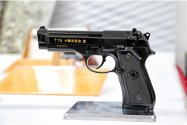Last week, the US Congress's US-China Economic AND Security Review Commission held a hearing on "
." The testimony from
, Center Fellow, Freeman Spogli Institute for International Studies at Stanford University and Non-Resident Senior Fellow, AEI, is particularly interesting. While there have been a lot of noises and chatters around the US Taiwan policy lately in the US think tank and policy community, most of them bordered on posturing and emotional outpouring and are mostly from the US perspective, with little or no assessment on China's capability, will, strategy and tactics when it comes to Taiwan. The testimony from Oriana Skylar Matro stands out in its more detailed assessment of those areas. As such I found her assessment and recommendations are more realistic, even though one doesn't necessarily agree with everything she has laid out.
The
is here. The following is the policy recommendation section:
The commission is mandated to make policy recommendations to Congress based on its hearings and other research. What are your recommendations for congressional action related to the topic of your testimony?
US policy needs to focus on shaping Chinese perceptions of their ability to successfully absorb Taiwan through military means. This proposition implies several things for US strategy.
Changes Need to Be Made to USMilitary Capabilities, Not US Policy. Ending the US policy of strategic ambiguity as some have argued would do little to improve cross-strait deterrence.47 The pivotal issue is not US resolve. Chinese leaders will be assuming US intervention when making their calculus. The main question will be whether Xi and other top leaders think the PLA can prevail despite US intervention. The US needs to develop the force posture and operational plans to deny China its objective, and credibly reveal these new capabilities. In the meantime, any extreme US policy changes, to include stationing US troops in Taiwan or helping Taiwan acquire nuclear weapons, would most certainly cross Beijing’s redlines and compel a military response before needed improvements in US military posture are implemented.
Changes in US Capabilities Should Focus on Intelligence, Surveillance and Reconnaissance (ISR); Resiliency; and Augmenting Firepower in the Strait. If the United States does not get adequate warning of an impending Chinese amphibious attack on Taiwan, the US military is unlikely to be able to stop a Chinese fait accompli. Because of this, Adm. Philip Davidson has recently advocated for securing about $1 billion to build an over-the-horizon radar in Palau and the Homeland Defense Radar–Hawaii, which could track ballistic missiles, and about $2 billion for “a constellation of space-based radars with rapid revisit rates,” to improve US regional force posture.49 Draft legislation calling for $378.6 million to “enhance indications and warning, sensor packages, the development of future intelligence, surveillance and reconnaissance platforms, and interoperable processing, exploitation, and dissemination architectures for the United States Info-Pacific Command” is a crucial step to address current shortfalls.50 US Indo-Pacific Command should be given top priority for overhead national assets to ensure constant monitoring of Chinese airfields and ports of embarkation as well.
On resiliency, the US military has been undergoing reviews of the resiliency issue for almost a decade. I believe a hybrid approach of large, concentrated bases in key allied countries with small, dispersed bases scattered across informal partners—some within the first island chain and others outside it—is the best path to pursue. In addition to enhancing resiliency, such a force posture would also greatly enhance deterrence because China is more sensitive to threats of horizontal escalation (that other countries would get involved) than vertical escalation (higher levels of force).
Lastly, firepower. If it launches an attack on Taiwan, its leadership has considered all the costs. It has considered the possibility of US intervention. The only thing that prevents China from absorbing Taiwan is brute force. The United States needs to pre-position networks of missile launchers and armed drones near Taiwan.52 As Bridge Colby has previously argued, more long-range munitions, especially anti-ship weapons, positioned in places such as Guam, Japan, and the Philippines (and ideally smaller island states in the second island chain) “would help make the US ready to blunt the initial waves of the Chinese amphibious fleet and air-assault elements.”53 If Chinese leaders know that their forces cannot physically make it across the strait, short of a declaration of independence, they will not consider trying.
Improving Taiwan Capabilities Is Important to Buy US Time, but Nothing Else. Taiwan will never be able to defend itself alone against mainland China, even with all the asymmetric capability in the world. Policymakers should encourage Taiwan to reform its strategy to embrace asymmetric approaches and encourage Taiwan to invest in cheap, expendable, mass-produced weapons systems.54 But the main objective is to add a defense layer in case the United States does not get enough early warning to amass forces before China launches its invasion. These approaches are not an alternative to the US defense of Taiwan.
Ask Congressional Research Service to Conduct a Study of US War Termination Behavior. The focus of this testimony is on the political and strategic factors influencing Chinese decision-making. While avoiding conflict is an important objective, ensuring that any war that does break out is as short and limited in violence as possible (and the US wins) is equally important. The US has a historical tendency toward mission creep and maximalist demands that undercut these goals. If a war breaks out over Taiwan, the United States needs to be prepared to return to the status quo antebellum, even if militarily victorious. If the US demands Taiwan independence after a military victory, we will be stuck fighting China for decades or Beijing will escalate to levels of violence we are unwilling to match or absorb.




